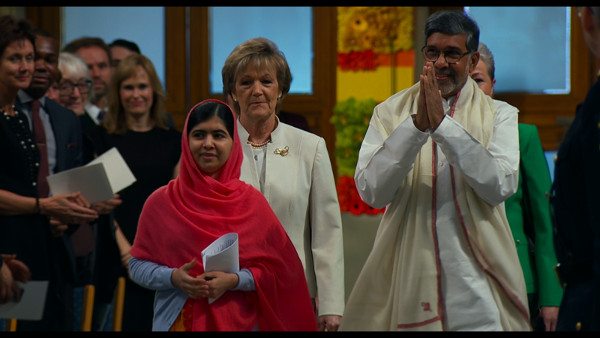
– Film Review by Cate Marquis –
“He Named Me Malala” spotlights Nobel prize-winning teen advocate of girls’ education
Stars: 4 out of 5
As a 15-year-old schoolgirl in Pakistan, Malala Yousafzai was targeted for assassination by the Taliban, simply for speaking out in support of girls’ education. Malala not only survived being shot in the head but recovered enough to become an international advocate for girls’ education and to become the youngest-ever winner of the Nobel Peace Prize.
In this country, educating girls is a given but it many parts of the world, it is a revolutionary act. In the small village in Pakistan’s Swat Valley where Malala’s parents lived, girls were not often educated but as the headmaster and founder of the village school, her father wanted his beloved oldest child, the daughter named for a female patriotic national hero, to go school. A bright, popular student who was top of her class, she admired and emulated her outspoken father.
“He Named Me Malala” takes a personal look at Malala Yousafzai, a young woman who has had a remarkable life even though she is still a teenager. Malala is still very close to her father, but part of the charm of this warm documentary is how it reveals her feisty, playful relationship with her two younger brothers. The siblings tease and gripe about each other like any brother and sister. Her oldest brother complains she is bossy, she says he is lazy. You know, like any family.
An affectionate portrait, this documentary from Davis Guggenheim is likely to further boost your admiration for this already admirable young lady. Malala comes across as funny, playful, bright, confident and charming, as well as a determined fighter for girls’ education. The scenes of family life are particular appealing with Malala and her brothers kidding around and one-upping each other around the kitchen table in the English home, the country where the family has lived since she brought there for treatment of her head wound. While Malala is close to her father, her older brother is close to their mother, a beautiful green-eyed woman whose discomfort about being the only girl in school cut short her own education.
The film uses attractive animated sequences to recount the family’s life in Pakistan, a country they still love, before the attack. It uses archival footage to recap the events of her life – news footage describing her advocacy in Pakistan, the assassination attempt, the international coverage of her struggle to recover from the gunshot to the head, her travels to various locations to speak out about education and finally her winning of the Nobel Peace Prize.
Growing up in the media spotlight, the teen is both passionate about education and a poised speaker on the subject. Dressing in modest Islamic fashion but eschewing the face covering that is traditional in her country, Malala’s poise and dignity rebuff opponents’ efforts to paint her as immodest, which would undermine her authority in speaking to Muslim families. As a speaker and advocate, she is self-confident and fearlessly direct. While she is close to her adoring father, who often travels with her and who is clearly her role model, she insists that her opinions are her own and she is no puppet.
The one subject on which talkative Malala becomes quiet is her injury and recovery, smoothly turning aside questions. Guggenheim shows this part of her life through footage of her hospitalization and recovery. Her head injury destroyed her hearing in one ear and partly paralyzed her face, but the video of her rehab sessions shows a remarkable comeback from disability.
While the film is appealing, it does fall short in a few areas. There is little on Pakistani culture or it offers no insights into the ancient traditions that lead some to see women’s rights as dangerous or destabilizing, or to conflate educating girls with colonialism or Western domination. The film also does not examine any lasting impact Malala’s sincere speeches and visits to girls’ school in developing nations really have. The film only lightly touches on how the family’s comfortable middle-class life in England, and Malala’s international fame, insulates them from the challenges and dangers girls face in the developing nations Malala visits while speaking on behalf of her cause.
Still, “He Named Me Malala” is a warm and charming portrait of a brave and determined young lady, who is an inspiration around the world.